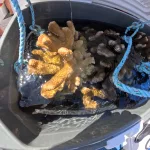A collaboration of conservation divers successfully removed and relocated nearly 11 years worth of coral growth from a decommissioned offshore fish farm pipe ring that was towed into the Honokohau Small Boat Harbor last week.
Divers from the DLNR Division of Aquatic Resources (DAR), The Nature Conservancy (TNC), and Arizona State University (ASU) teamed up to remove hundreds of large, healthy, native coral heads from the ring, which supported the teepee-like structure used to raise kampachi (yellowtail or amber jack). Four of the fish pens remain in operation and visible just off a runway at the Ellison Onizuka Kona International Airport.
The partners have been working closely together over the past couple of years to build capacity for coral restoration and for emergency response. During the three-day long operation, corals on top of the pipe were not recovered as prolonged exposure to air kills them, but most everything below the water line was removed using chisels and hammers.
Those corals sank to the bottom of the harbor where divers collected them in milk crates that were lifted onto boats. Large coral heads were gingerly placed into water-filled coolers, while smaller ones were bubble-wrapped and placed in coolers.
The larger corals were taken by boat back to the reef, in-shore of the fish pens. The full crates were then lowered to the ocean floor by divers. The smaller, wrapped corals were taken to a new coral nursery at the National Energy Laboratory of Hawai‘i.
The ʻĀkoʻakoʻa Coral Restoration Nursery opened in May and is the first large, land-based coral nursery on Hawai‘i Island.
The dive teams collected hundreds of healthy colonies. The coral heads returned to the ocean will be affixed to existing reef structure this week using a special marine epoxy.
In a press release Blue Ocean Mariculture CEO Dick Jones said, “We are deeply committed to the health and resilience of Hawaiʻi’s marine ecosystems, so we’re honored to partner with the DLNR and the other partners on this coral reef restoration initiative. By providing reef samples from our net pens off the Kona Coast, we can help support the regeneration of vital species in our coral reefs, reinforcing both environmental sustainability and the balance of Hawaiʻi’s coastal waters. This collaboration is a natural extension of our team’s dedication to Hawaiʻi’s ocean ecosystems and to preserving their vitality for future generations.”
DLNR Photo
